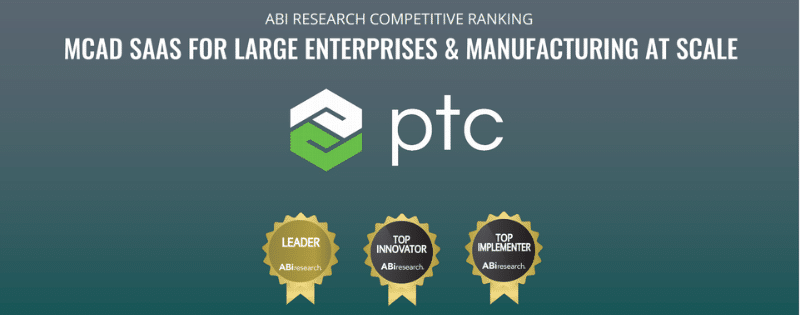Differentiating between CAD programs is challenging – they all claim to have the tools and features you need to design advanced products. We’ve been working with CAD systems for many years, so we have a clear understanding of what features actually matter and which platforms work best. There’s plenty of solutions to choose from, so we are focusing this CAD software comparison on Creo vs AutoCAD.
CAD Software Comparison Feature Faceoff
Product Vision
Selecting a CAD solution is an important decision. While you want to make sure you pick the solution that has everything you require now, you also want to be sure that the solution will be able to adapt to your future needs. You don’t want to have to go through the selection process all over again.
 When it comes to product vision and the future of CAD, when discussing Creo vs AutoCAD, there’s no contest. Creo’s long term product vision truly outshines that of AutoCAD by including advanced IoT and additive manufacturing extensions. It includes support for VR and AR to optimize processes and provide additional prototyping options. PTC, and therefore Creo, are focused on helping companies complete their digital transformation and be revolutionary in Industry 4.0.
When it comes to product vision and the future of CAD, when discussing Creo vs AutoCAD, there’s no contest. Creo’s long term product vision truly outshines that of AutoCAD by including advanced IoT and additive manufacturing extensions. It includes support for VR and AR to optimize processes and provide additional prototyping options. PTC, and therefore Creo, are focused on helping companies complete their digital transformation and be revolutionary in Industry 4.0.
It’s not that AutoCAD doesn’t have a product vision; it is just very simple compared to the clearly defined vision of PTC. AutoCAD is still promoting its mobile apps and only mentions IoT in passing. While AutoCAD will likely continue updating its platform with the latest features, continuing to advance to support interconnected operations does not appear to be a top priority.
Creo’s clear focus on innovation and supporting the digital transformation provides a better long-term product vision compared to AutoCAD.
3D CAD Modeling
Creo has more than 20 extensions to support its comprehensive 2D and 3D modeling capabilities including those for metalworking, large assemblies, molding, piping and cabling, additive manufacturing, NC milling, etc. These extensions are grouped into 5 different package offerings that can provide various levels of functionality based on your organization’s needs and budget availability.
AutoCAD has a comprehensive suite of 3D and 3D modeling capabilities that are comparable to Creo. It includes mobile applications and other toolset add-ons that help design for mechanical design, electrical design, and architecture. It also offers a drawing comparison tool that helps designers highlight the differences between drawing revisions.
Overall, when it comes to core CAD functionality and Creo vs AutoCAD there are very few differences in basic features. The true difference comes into play when you talk about more advanced capabilities.
Ease of Use
Creo’s latest update has refreshed the UI so it is super easy to use – similar to a web experience. If you use other PTC programs, the interface will feel very familiar and require little additional training. AutoCAD is also easy to use, but its interface feels outdated and clunky, giving Creo a slight edge in this category.
Creo’s revamped UI makes it easy to navigate between menus and complete design tasks.
Supported Industries
 Creo has specific tools and functionalities to support a range of targeted industries including:
Creo has specific tools and functionalities to support a range of targeted industries including:
- Smart cities
- Retail and consumer products
- Oil and gas
- Manufacturing
- Life sciences
- Automotive
- Aerospace and defense
While this list isn’t exhaustive there are strong concentrations in each vertical to ensure your team has everything they need to finish projects without requiring other outside solutions. In addition to industry verticals, Creo also has a range of industry specific-extensions that take its industry support beyond just the required rudiments. These additional tools help teams address difficult problems that can slow down design and manufacturing processes.
AutoCAD, on the other hand, has a limited number of toolsets that offer broad capabilities. That’s okay as far as it goes, but without specialization in any category, it can be hard to have a positive impact on productivity.
Creo includes a range of industry-specific tools and features.
Deployment Options
Both Creo and AutoCAD are offered as cloud or on-premise solutions. AutoCAD classifies its cloud deployment primarily as a collaboration tool, which is only one part of the equation. PTC Creo views cloud as the data center of the future and has made sure that its cloud offerings are efficient, secure, and cost-effective. While it may seem that Creo is the winner here, neither solution limits users to what they can or cannot do in the cloud – so organizations could use AutoCAD’s cloud offering in the same way as PTC Creo if they choose. Since there are no defined limitations, we are calling this one a tie.
Creo and AutoCAD are offered via the cloud or on-premise deployments.
Collaboration and Integration
 Creo allows users to create secure collaborative project workspaces to enable easy interactions with suppliers and customers. These collaboration tools support role-based security that limits access to just the information that a specific role requires. Creo also further enhances collaboration with its Unite Technology platform, which allows users to open and work with files generated by any CAD system without conversion. The ability to open any file type makes it significantly easier to introduce Creo into the mix of legacy software solutions.
Creo allows users to create secure collaborative project workspaces to enable easy interactions with suppliers and customers. These collaboration tools support role-based security that limits access to just the information that a specific role requires. Creo also further enhances collaboration with its Unite Technology platform, which allows users to open and work with files generated by any CAD system without conversion. The ability to open any file type makes it significantly easier to introduce Creo into the mix of legacy software solutions.
AutoCAD talks about its advanced collaboration features but is not at the same level as Creo. Users are limited to very few workable file types and permission tools are not as advanced. The limits of workable file types negatively impact AutoCAD’s ability to integrate with other tools, which is often required in many industry environments.
Creo improves collaboration with secure workspace and Unite Technology tools.
Education and Support
Creo and AutoCAD include online education and support. This includes troubleshooting, service pack downloads, and tutorials to get users up to speed quickly and to stay productive. AutoCAD’s support offerings are all included on one page, making them particularly easy to find. However, while Creo’s support is more spread out, this is made up for with integrated wizards and tutorials that are integrated directly into the Creo UI.
Creo and AutoCAD include educational and support materials to keep users productive.
CAD Software Comparison Winner: PTC Creo
When it comes to comparing Creo vs AutoCAD, Creo comes out on top. When looking at basic functionality both solutions are comparable, but most organizations require the more advanced and industry-specific tools that Creo can provide. We will admit, as a PTC reseller, we are slightly biased towards PTC products. However, with many years of experiences helping people select CAD and manufacturing solutions – we truly believe that Creo is a better product that will help you achieve greater productivity.
Interested in seeing how Creo stacks up in other CAD software comparisons? Check out our other comparison posts:

